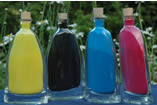 |
MICR
Toner for Ferrofluidmake your own
What is MICR Toner?
MICR stands for Magnetic Ink Character
Recognition. It is a specialist toner used for printing cheques.
It is highly magnetic for producing magentic print. This enables
cheques to be scanned automatically. Certain laser printer models
are designed for printing with MICR toner. We stock MICR toner alongside
regular toner, so that these special cartridges can be refilled.
There is another use for MICR toner - making ferrofluid. We have
been asked many times to supply bottles of MICR toner for this purpose.
If you are looking to buy a bottle, the button below takes you to
our product page where it is available.
What is Ferrofluid?
Ferrofluid is a magnetic fluid made out
of very small pieces of iron, or iron oxides, suspended in a liquid.
The shapes and flow of ferrofluid show how magnetic field lines
curve around magnetic objects. It is surprising and beautiful to
see.
What do I need to make Ferrofluid?
There are usually three things you
need:
-A source of tiny iron particles - we suggest using MICR toner.
-A carrier fluid (to make it flow)
-A surfactant (ie. emulsifier),
to keep the particles from clumping.
Once you have iron particles, they can be suspended in vegetable
oil, mineral oil, or lightweight motor oil. Some suggest a mixture
of isopropanol and water, but anything with water will cause your
iron to rust. The less viscous the carrier fluid, the more dramatic
the peaks will be. Finding a good surfactant so you have a suspension,
rather than iron sitting in the bottom of a bottle of fluid, is
the challenge. On the other hand, iron sitting in the bottom of
a bottle of fluid is also interesting to experiment with. |
 |
| |
|
 |
 |
| |
 |
Background
Information
It’s generally difficult to
make a magnetic liquid because once you melt a magnetic material
(like iron) it’s not magnetic anymore. When heated past the
Curie point magnetic materials lose their magnetism – the
thermal energy in the metal overwhelms the tendency of the magnetic
domains to align with each other. The melting point for iron is
1000°C, but its Curie point is 800°C. Ferrofluid was originally
developed by NASA because they needed to be able to control liquids
in low gravity. Today they’re used to damp high-end speakers,
and as liquid seals in hard drives and other applications. |
 |
| |
|
 |
 |
| |
 |
Experiment Ideas
Here are some ideas to show magnetic
fields. You will need a strong magnet to carry out these experiments.
Please note we have not tried these ourself:
1. Pour the magnetic fluid into a Petri dish, or in a vial or test
tube, and put a magnet underneath.
2. Put clear mineral oil in a vial or test tube and add a small
amount of fluid, and put a magnet next to it.
3. Put nuts and bolts and other steel/iron objects in the magnetic
fluid and bring a magnet close to it. Make sure there is something
between the magnet and the iron object (such as a Petri dish) or
else the iron object will jump to the magnet.
4. Attach a string to a stack of magnets, and lower into a test
tube. Lower the test tube towards magnetic fluid in a Petri dish.
The fluid will leap from the Petri dish to the bottom of the test
tube, defying gravity and delighting the audience. To make the jump
a little more dramatic you can put another magnet beneath the petri
dish. You should be able to remove the magnets from the test tube
(without the fluid following up the outside of the tube) by pulling
them up very swiftly (making the fluid fall back into the petri
dish). Alternatively, you can cut a hole in a rubber stopper the
size of the test tube, and fit that over to keep it in place.
|
 |
| |
|
 |
 |
| |
 |
Purchase
a bottle today!
We supply it in 510g bottles. It costs
£54.95 plus vat per bottle. You may click on the button
below to go to the product page and order MICR
toner for ferrofluid.
|
 |
| |
|
 |
 |
|


